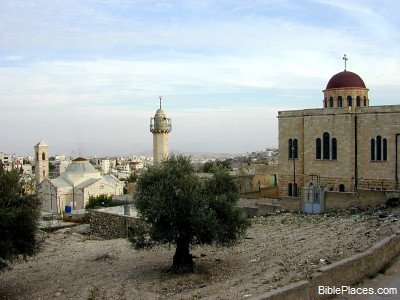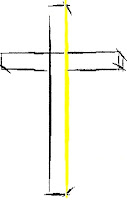www.magnificat.net/english/flip_com_oeuvre/index.asp
MAGNIFICAT Holy Week 2013-03-26.
The Art Essay of the Month
Mocking of Christ ("1596),
Annibale
Carracci (1560-1609),
Pinacoteca Nazionale, Bologna, Italy.
ROME granted Annibale Carracci's Mocking
of Christ a singular honour, previously bestowed only on Raphael. This painting crowned Carracci's catafalque during his 1609 funeral at the Pantheon, just as Raphael's Transfiguration had
graced his coffin in the same church a century earlier.
Unlike
Raphael's monumental altarpiece, the Mocking
of Christ was a smaller, more intimate work, meant for personal devotion. The commission had come from Annibale's most important patron, Cardinal Odoardo Farnese, scion of the family that had produced Pope Paul III. Never intended to embellish
one of the numerous chapels endowed by the Farnese, it
graced the private quarters of the
cardinal's palace.
Three figures occupy the canvas
expanse. Christ dominates the scene, his
head and shoulders filling the centre; one soldier reaches from the lower right corner to place a crown of
thorns upon his brow, while another, immersed in shadows, turns, perhaps to call his comrades. The frame encloses only the heads and shoulders, focusing our attention tightly.
We find ourselves standing, perhaps uncomfortably, at the heart
of the action.
The Gospels describe how Pilate
ordered the scourging of Christ before handing him
over to be crucified. After the flagellation, the
Roman soldiers laid a purple mantle over his soldiers, thrust a reed in his hands, and
fashioned a crown of thorns which they
pushed on his head, while mocking him with salutes and bows as King of the Jews..
In Carracci's scene, the battalion of soldiers is reduced to two, but in this close-up
the viewer perceives Jesus' pain more intensely. No longer
are we bystanders watching
from a safe distance, as
in Renaissance frescoes. Annibale thrusts us to the forefront.
One might easily imagine oneself as one of the soldiers in the realisation of how our own sinfulness makes a mockery of Christ's great love for us.
Annibale's brush erases the welts from the
scourge, leaving pristine the flesh of Christ. Only his face reveals his suffering; Christ appears exhausted, as if
the weight of human sin is far more difficult to bear than the physical torture of the soldiers.
Carracci did not ignore the written Scriptures lightly. As one of
the preferred painters of Counter Reformation patrons, he
was keenly aware of how the Church prized fidelity to the Gospels in art. As a Christian and a proponent
of artistic naturalism, Carracci's decision to omit the blood shed by Christ and the lacerations of his flesh carried deeper meaning.
Carracci was the forerunner of a new breed of artist, one
who would be able to flank theologians and preachers in
trying to render the Gospel
more vivid and personal to a public rocked by the Protestant Reformation. One of Annibale Carraccci's closest
advisors was Archbishop Giovanni Battista Agucchi, member of the innermost court of Pope Clement VIII.
This pope, who had led the Church into the Jubilee year of 1600, fervently believed that art and beauty
could inspire the faithful to spiritual greatness. Archbishop
Agucchi, consulting with Carracci
and his circle, wrote a treatise on beauty and art
to guide future generations of painters to use their talents for evangelisation.
Carracci's Christ radiates beauty. He is luminous while his tormentors are swarthy, his hair curls softly around his shoulders, and his fingers are long and elegant. The red mantle cascading from his shoulders evokes his mortal flesh and his human blood shed for us.
The gnarled fist that presses the crown on Christ's head forms a dramatic contrast with his graceful hands bound by the Roman rope.
Christ's
serene beauty draws us to him.
We gaze
easily upon his fair features and are all
the more outraged to see the soldiers mar his noble face with their rough hands and vicious thorns. He is surrounded by ugliness, cruelty, and ignorance, but the reality of their brutality cannot outshine the beauty of his truth.
Cardinal Ratzinger, addressing a meeting in Rimini in 2002, spoke
of beauty and truth in terms
that
seem intended for Annibale's painting.
"In the Passion of Christ," he said,
"the experience of the beautiful has received new depth and new realism. The One who
is
Beauty itself permitted himself to be slapped in the face, spat upon, crowned with thorns."
The most powerful aspect of Carracci's painting, however, is Christ's
expression. Head bowed with weariness, eyes heavy with pain, Jesus nonetheless
confronts his aggressor. His face bears neither
defiance nor rancour, but profound compassion. From
the depths of his suffering, Christ understands
the human condition even better. His hands, bound
by his
captors, do not struggle to
break free or remove the crown from his head, but
reach out, even at this extreme moment, to
draw another
soul to himself. Annibale painted the ultimate
form of self-giving, illustrating the words of John the Evangelist, "now he showed how perfect his love
was" (Jn 13:1).
Annibale left a vacant space between Christ and his persecutor, meant to be filled by the viewer. As we stand before it, the outstretched hand
of Christ reaches for us, whose sins are like the thorns pressing into his flesh, to call us out of our darkness and into his light.
• Elizabeth Lev Writer and professor of art history in Rome, Italy.
To view this masterpiece in greater detail, visit: www.magnificat.com









